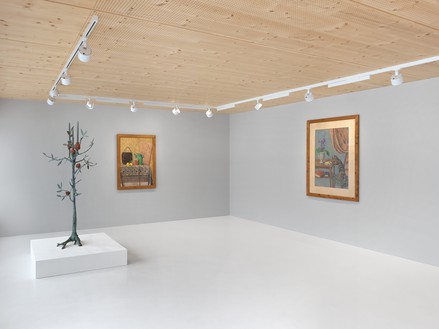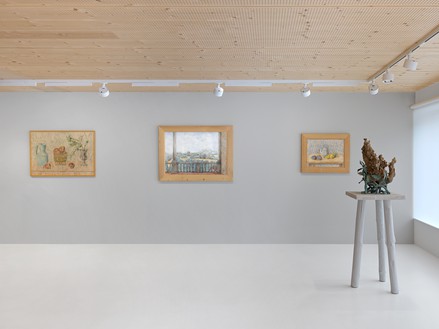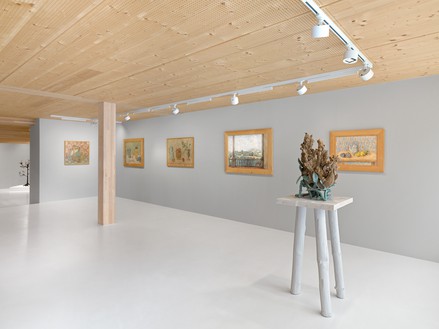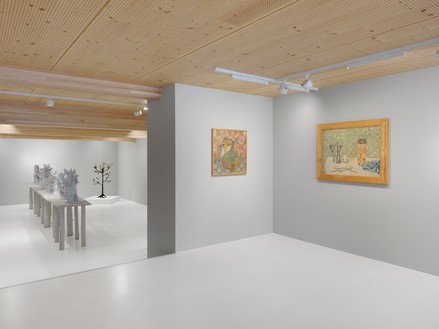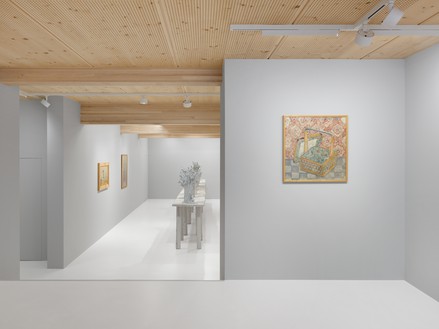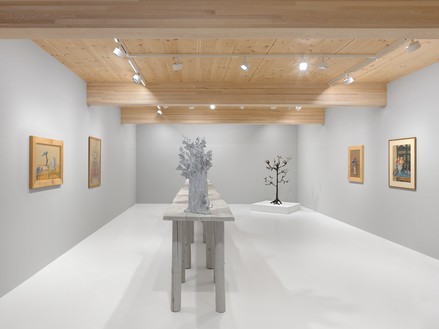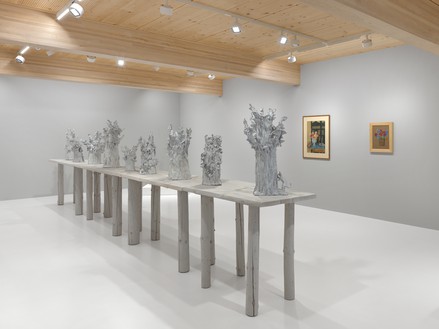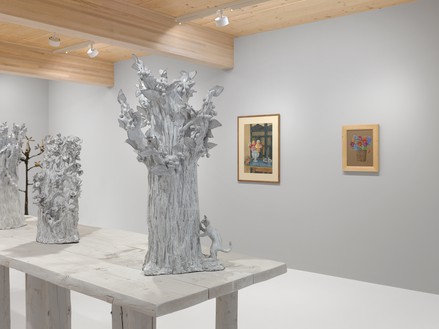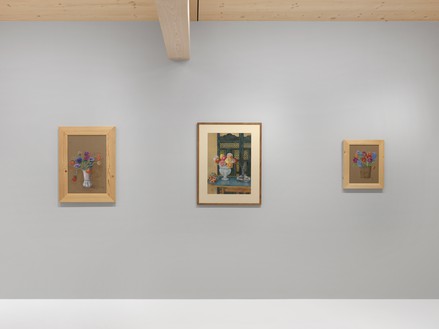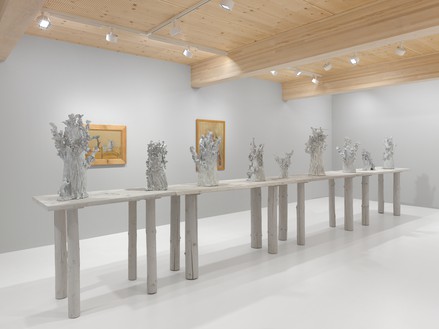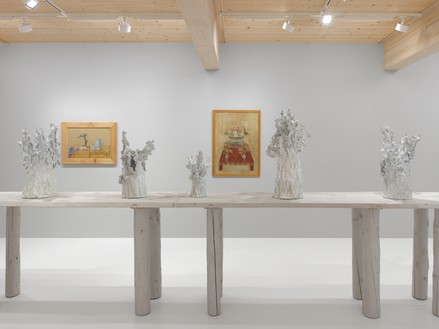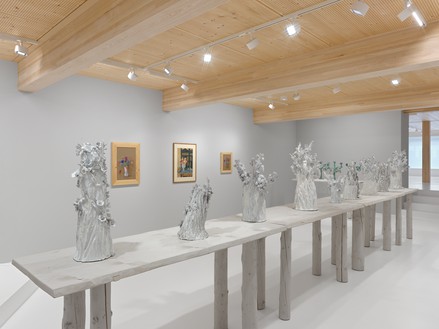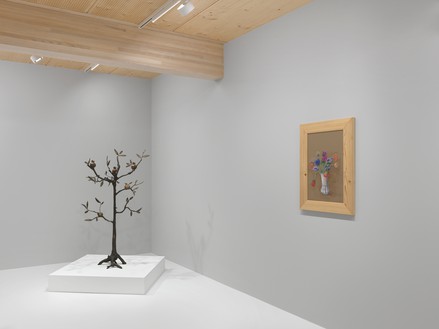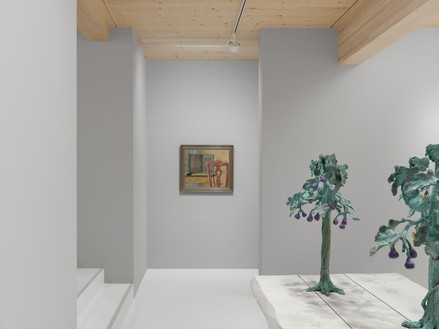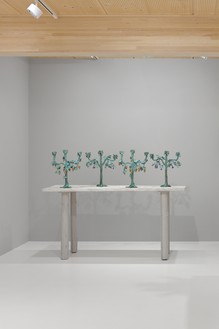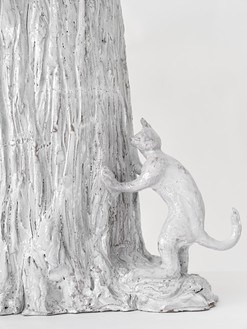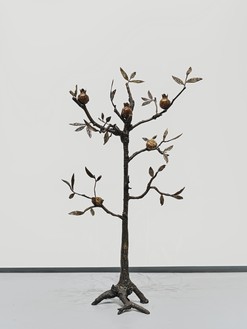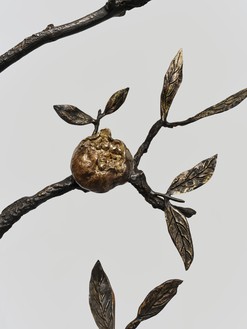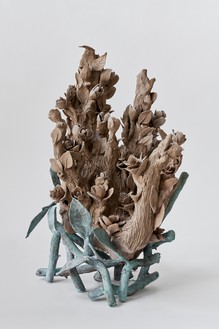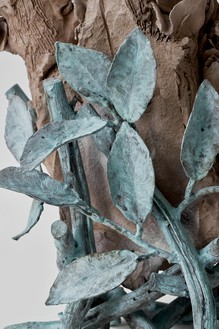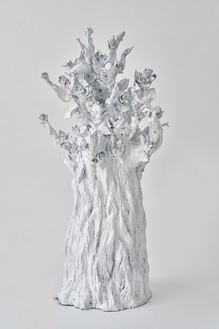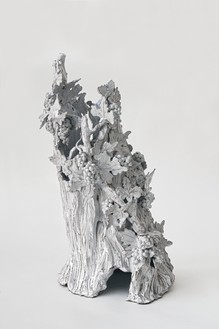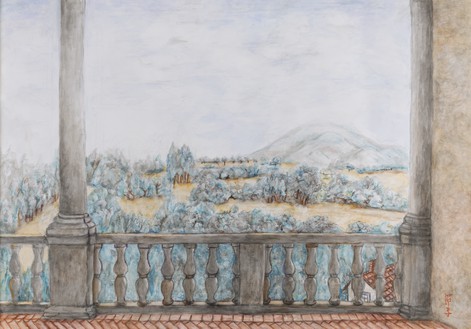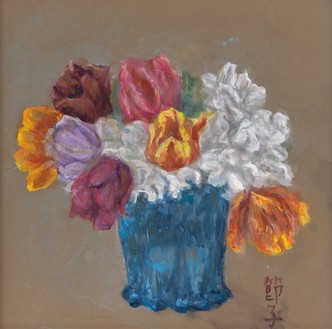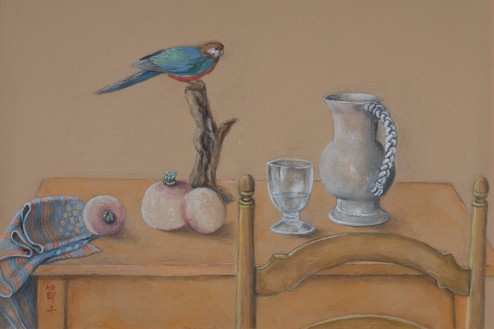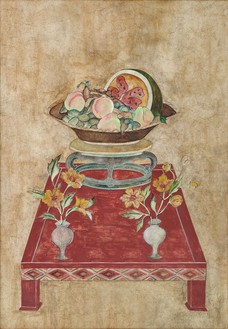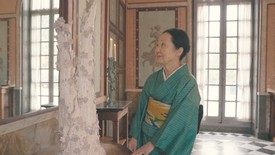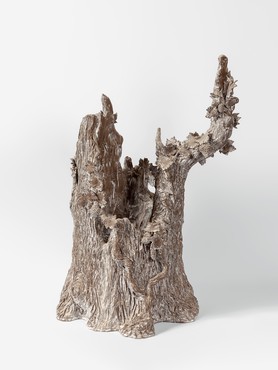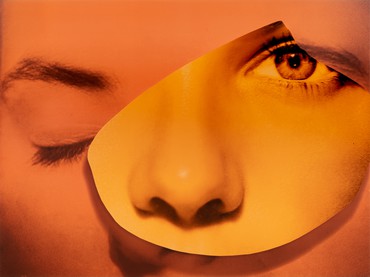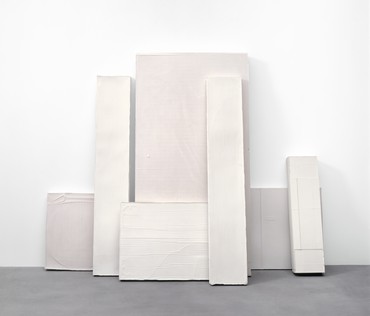About
Nature doesn’t need us, but we need nature.
—Setsuko
Gagosian is pleased to announce Into Nature, an exhibition of new and recent ceramic and bronze sculptures, paintings, and works on paper by Setsuko at the gallery in Gstaad. Since 1977, Setsuko has resided in the Grand Chalet of Rossinière, close to Gstaad, making this an opportunity for her to exhibit within reach of her Swiss home. Into Nature furthers the bodies of work presented in Into the Trees, Setsuko’s debut exhibition at Gagosian Paris in 2019, and Into the Trees II, a solo presentation at Gagosian Rome in 2022.
On view in Gstaad are new ceramic sculptures, produced at Astier de Villatte’s Paris workshop and made of terra-cotta glazed in white enamel. Setsuko’s renderings of trees, with their delicately modeled representations of acorns, blooms, foliage, and fruit, emphasize the rooted solidity of their trunks to convey lasting strength and emergent growth. Reminiscent of Japanese ceramics dating back to the age of Jōmon earthenware (c. 10,500–300 BCE), these works also refer to the animistic Japanese religion Shintō, to which trees are of central symbolic importance.
Die Natur braucht uns nicht, aber wir brauchen die Natur.
—Setsuko
Gagosian freut sich, Into Nature, eine Ausstellung neuer, kürzlich entstandener Keramik- und Bronzeplastiken, Gemälde und Arbeiten auf Papier von Setsuko in der Galerie in Gstaad anzukündigen – eine Gelegenheit für Setsuko, die seit 1977 im «Grand Chalet» in Rossinière, einem Dorf unweit von Gstaad lebt, in unmittelbarer Nähe ihres Schweizer Wohnsitzes auszustellen. Into Nature knüpft an die Werkreihe Into the Trees an, die 2019 am Standort Paris anlässlich ihrer ersten Ausstellung bei Gagosian gezeigt wurde, sowie an Into the Trees II, die an einer Einzelausstellung in der Römer Galerie von Gagosian im Jahr 2022 zu sehen war.
In Gstaad werden neue, weiss glasierte Terrakotta-Plastiken ausgestellt, die im Atelier Astier de Villatte in Paris entstanden sind. Die Gestaltung der Bäume mit fein modellierten Eicheln, Blüten, Laub und Früchten betont, wie tief und solid die Stämme verwurzelt sind, was ein Gefühl von bleibender Kraft und frischem Wachstum vermittelt. In Anlehnung an die japanische Töpferkunst, die bis ins Jōmon-Zeitalter (ca. 10’500–300 v. Chr.) zurückreicht, klingen in den Werken auch Elemente des Shintoismus, der animistischen Religion Japans, an, wo Bäume eine zentrale symbolische Bedeutung haben.
Das Motiv der neuen Plastik Le chat et l’oiseau (2023) ist der Kirschbaum. Er versinnbildlicht die Intensität und Flüchtigkeit des Lebens. Daneben sind eine Katze und ein Vogel zu sehen, die in der japanischen Volkskunst häufig vorkommen. Fantaisie de Magnolia (2022) ist eine Plastik, die ebenfalls zum ersten Mal ausgestellt wird. Darin kombiniert Setsuko Terrakotta und patinierte Bronze – eine Ausnahme in ihrem Schaffen. Aus einem Nest blassgrüner Halme und Blätter ranken die titelgebenden Magnolienblüten empor. Zu sehen bei Into Nature sind zudem aufsehenerregende grossformatige neue Versionen von Setsukos Granatapfel-Leuchten aus Bronze, Grand Chandelier (grenades) (2023), die mit patinierten Blattformen überzogen sind und in zwei verschiedenen Farbtönen hergestellt werden. Sie sind zusammen ausgestellt, nebst kleineren Leuchterplastiken aus Bronze mit Feigen- und Rebenmotiven.
Eine Werkgruppe besteht aus Gemälden und Arbeiten auf Papier – Techniken, die Setsukos Werdegang als Künstlerin seit den 1960er-Jahren, als sie in Rom tätig war, bis zur COVID-19-Pandemie geprägt haben. Diese Arbeiten werden abgerundet durch das Werk Paysage d’Italie (2023), auf dem die Veranda ihres früheren Hauses in Montecalvello bei Rom zu sehen ist, das sie zusammen mit Balthus bewohnte. Zu sehen sind ferner neuere Arbeiten auf Papier mit bunten Blumenmotiven, delikaten Stillleben und Wohnräumen. Diese Motive sind im zweidimensionalen Raum so angeordnet, dass sie eine stille Intimität verströmen und den Besucher, die Besucherin in eine kontemplative Betrachtung der dargestellten Alltagsgegenstände und -szenen versenken. So verbinden sie traditionelle japanische mit moderner europäischer Ästhetik.
In allen Plastiken gibt Setsuko prächtige Motive aus der Natur mit vibrierenden, taktilen Oberflächen wieder. In einer Symbiose von Leben und Tod verbindet sie organische mit konstruierten Elementen. Aus den Gouache- und Aquarellbildern mit Stillleben, Blumenarrangements, Innenräumen und Landschaften spricht Lebensfreude, die durch die Formen aus der Natur, die menschengemachten Gegenstände und die atmosphärischen Räume verkörpert wird. Setsuko schlägt einen Bogen von fernöstlichen Traditionen zu westlichen Konzepten aus dem 20. Jahrhundert und nimmt den Betrachter, die Betrachterin durch ihre poetische und doch präzise Interpretation von Alltagsgegenständen und Elementen aus der Natur mit auf eine sehr persönliche bildnerische Erkundungsreise.
Gagosian bringt demnächst die erste Monographie über Setsuko heraus, die eine Übersicht über ihr künstlerisches Schaffen von den 60er-Jahren bis heute sowie einen Essay der Schriftstellerin Shan Sa enthält.
La nature n’a pas besoin de nous, mais nous avons besoin de la nature.
—Setsuko
Gagosian a le plaisir d’annoncer, dans sa galerie de Gstaad, Into Nature, une exposition de nouvelles céramiques et de sculptures en bronze récentes, de peintures et d’œuvres sur papier de Setsuko. L’artiste réside depuis 1977 au Grand Chalet de Rossinière, près de Gstaad, ce qui lui donne la possibilité d’exposer non loin de sa maison suisse. Into Nature s’inscrit dans le prolongement des créations que Setsuko a présentées dans Into the Trees, sa première exposition chez Gagosian Paris en 2019, et Into the Trees II, une exposition individuelle chez Gagosian Rome en 2022.
De nouvelles sculptures en céramique produites dans l’atelier parisien Astier de Villatte, réalisées en terre cuite vernissée d’émail blanc, seront présentées à Gstaad. Setsuko évoque les arbres avec une représentation toute en délicatesse de glands, de fleurs, de feuillages et de fruits, ce qui amplifie le solide enracinement de leurs troncs tout en exprimant une force persistante et une croissance émergeante. Ses œuvres, qui rappellent les céramiques japonaises de l’époque des faïences du Jōmon (de 10 500 à 300 av. J.-C.), se réfèrent aussi au Shintō, religion animiste japonaise, dans laquelle les arbres revêtent une importance symbolique centrale.
La nouvelle sculpture de Setsuko, Le chat et l’oiseau (2023), représente un cerisier en fleurs, métaphore de l’intensité et de la fugacité de la vie, accompagné d’un chat et d’un oiseau, tous deux des symboles récurrents du folklore japonais. Fantaisie de Magnolia (2022), une autre sculpture qui n’a encore jamais été exposée, est la seule œuvre de l’artiste qui combine des éléments en terre cuite et en bronze peint ; les fleurs en terre cuite de la plante émergent d’un nid métallique fait de tiges et de feuilles de couleur vert pâle. Into Nature inclut aussi de nouvelles versions des chandeliers exceptionnels en bronze. Grand Chandelier (grenades) (2023), que Setsuko a créés en grand format et qui sont couverts de feuilles peintes dans deux patines colorées différentes. Ces chandeliers sont exposés en même temps que des candélabres sculpturaux en bronze de plus petite taille ornés de motifs de figues et de vigne.
Une série de peintures et d’œuvres sur papier de Setsuko retrace son évolution artistique depuis les années 1960, lorsqu’elle était basée à Rome, jusqu’à la pandémie du COVID-19. Ces œuvres sont complétées par Paysage d’Italie (2023), une nouvelle étude paysagiste représentant la loggia de son ancienne maison de Montecalvello près de Rome, où elle a vécu avec Balthus. Des travaux récents sur papier montrant des bouquets de fleurs éclatants font aussi partie de l’exposition, de même qu’une sélection de gracieuses natures mortes et de tableaux d’intérieur. Ils apportent intimité et force tranquille aux espaces picturaux plats tout en synthétisant l’esthétique moderniste des traditions japonaises et européennes en une observation contemplative d’objets et de décors familiers.
Dans toutes ses sculptures, Setsuko enrichit des sujets naturels sublimes au moyen de surfaces tactiles luxuriantes en réunissant des éléments à la fois construits et organiques pour dépeindre la symbiose qui existe entre la vie et la mort. Dans ses gouaches et ses aquarelles représentant des natures mortes et des arrangements floraux, des intérieurs et des paysages, Setsuko transmet l’énergie vitale insufflée par les formes naturelles, les objets travaillés et les espaces atmosphériques. En combinant les traditions orientales historiques et les idées occidentales du XXe siècle, Setsuko présente au public une exploration très personnelle et met en scène des objets du quotidien et des êtres vivants de manière à la fois lyrique et précise.
Gagosian publiera prochainement la première monographie de Setsuko en lien avec la galerie, qui retracera en détail le travail de l’artiste depuis les années 1960 jusqu’à nos jours. L’ouvrage comprendra un essai de la romancière Shan Sa.
#SetsukoKlossowskadeRola
Artist
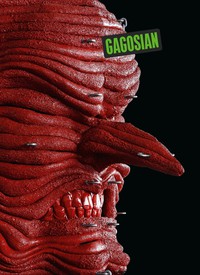
Now available
Gagosian Quarterly Fall 2022
The Fall 2022 issue of Gagosian Quarterly is now available, featuring Jordan Wolfson’s House with Face (2017) on its cover.
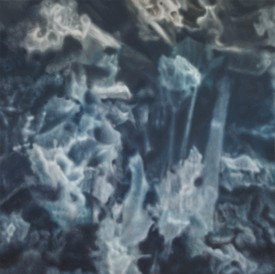
In Conversation
Setsuko and Y.Z. Kami
The artists address their shared ardor for poetry, the surfaces of painting, and nature.
Regards de Setsuko
Join Setsuko on a tour of her exhibition at the Musée national des châteaux de Malmaison et Bois-Préau in Rueil-Malmaison, France, the former residence of Empress Joséphine. The video brings together the artist; Isabelle Tamisier-Vétois, chief curator, and Élisabeth Caude, director, Musée national des châteaux de Malmaison et Bois-Préau; and Benoît Astier de Villatte, cofounder of the atelier Astier de Villatte, Paris. They discuss the origins and development of the project, which is designed as a dialogue between Setsuko’s work and the decorative ceramics held in the museum’s collection.
The Grand Chalet: An interview with Setsuko
On the twentieth anniversary of Balthus’s death, Setsuko gives an intimate tour of the Grand Chalet and reflects on how the 1754 Swiss mountain home enriched their lives as artists.
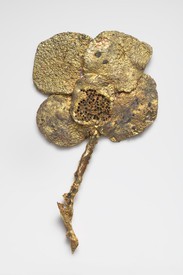
Augurs of Spring
As spring approaches in the Northern Hemisphere, Sydney Stutterheim reflects on the iconography and symbolism of the season in art both past and present.
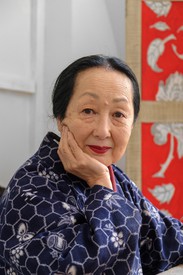
Work in Progress
Setsuko
Setsuko Klossowska de Rola and Benoît Astier de Villatte, of the Astier de Villatte atelier in Paris, first met at the Académie de France in Rome’s Villa Medici, where Setsuko lived when her late husband, the painter Balthus, was the school’s director. Here they discuss Setsuko’s newest body of terra-cotta works, produced at Astier de Villatte, with Gagosian’s Elsa Favreau.
News
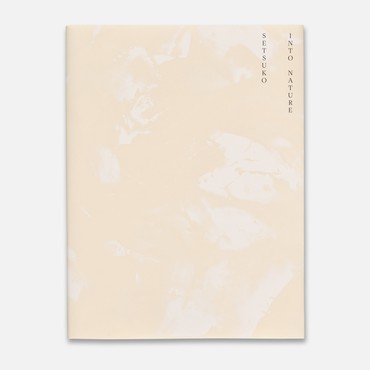
Book Signing
Setsuko
Into Nature
Thursday, April 25, 2024, 6–8pm
Gagosian, rue de Ponthieu, Paris
To celebrate the publication of her new book, Into Nature, Setsuko will sign copies at Gagosian, Paris, among a special installation of her works. Into Nature commemorates Setsuko’s recent exhibition of the same name at Gagosian, Gstaad, featuring ceramic and bronze sculptures, paintings, and works on paper. In addition to plates, exhibition views, and archival photography, the publication features a foreword by the artist and a text by novelist and poet Shan Sa, who was formerly an assistant to Setsuko. Published by Gagosian, the book will be available for purchase at the event, which is free to attend.
Setsuko: Into Nature (New York: Gagosian, 2024)
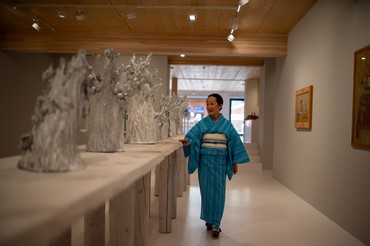
Tour
Setsuko
Into Nature
Saturday, August 19, 2023, 4pm
Gagosian, Gstaad
Join Setsuko for a tour of her exhibition Into Nature, on view at Gagosian, Gstaad, through September 10. The exhibition features new and recent ceramic and bronze sculptures, paintings, and works on paper by the artist. Since 1977, Setsuko has resided in the Grand Chalet of Rossinière, close to Gstaad, making this an opportunity for her to exhibit within reach of her Swiss home.
Setsuko in her exhibition Into Nature at Gagosian, Gstaad, 2023. Artwork © Setsuko. Photo: © GstaadLife Magazine/Sven Pieren
